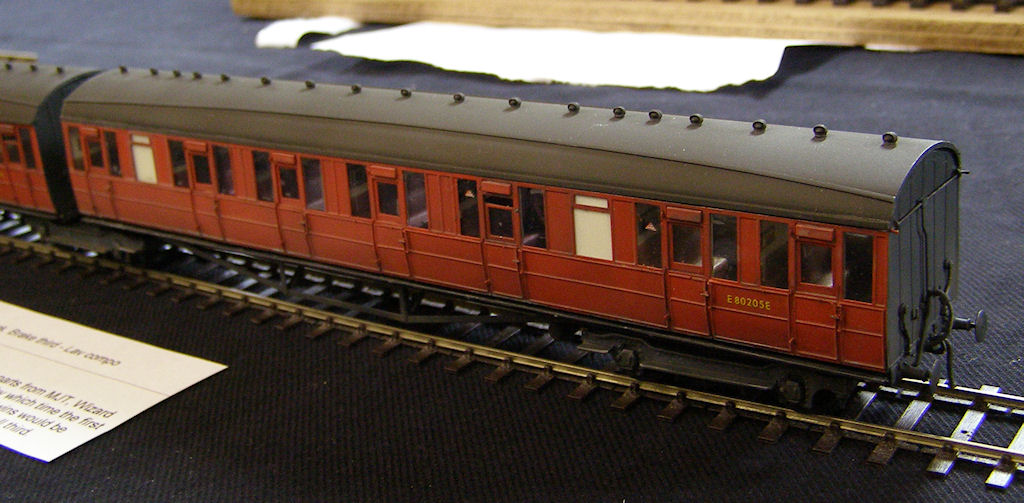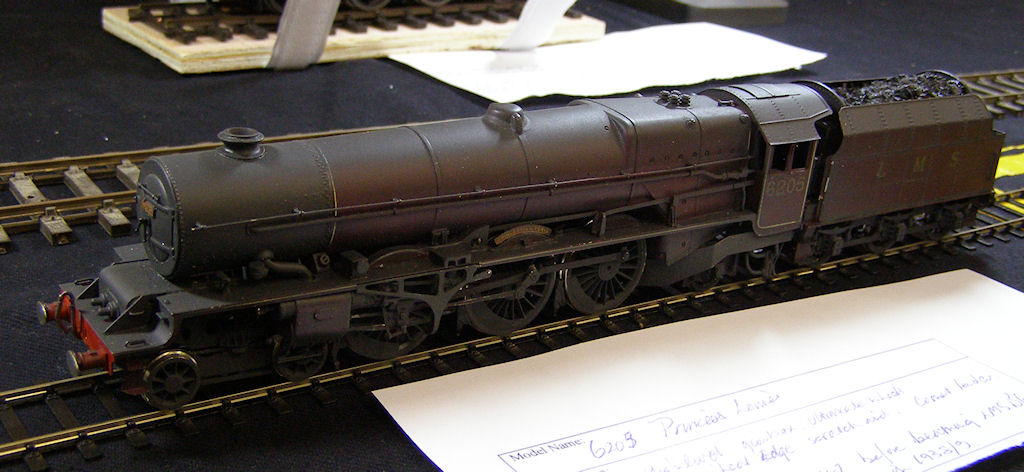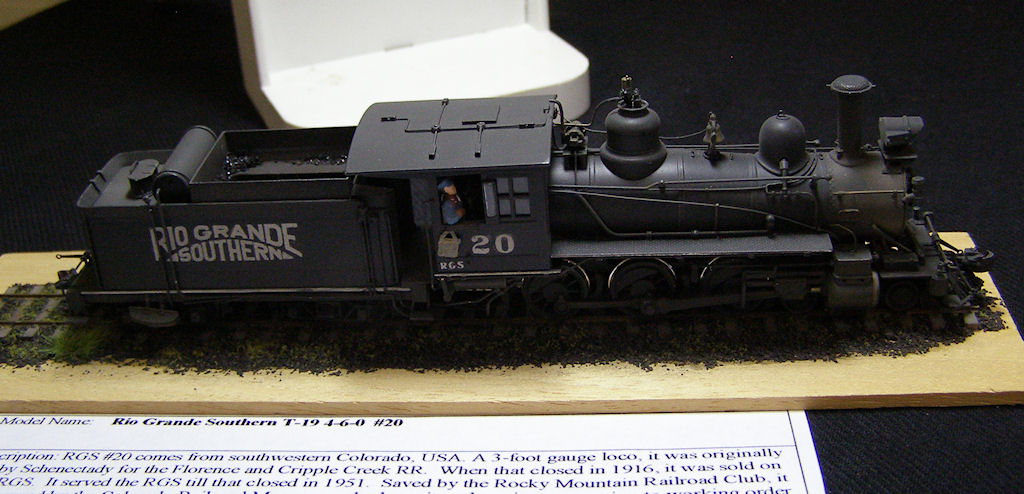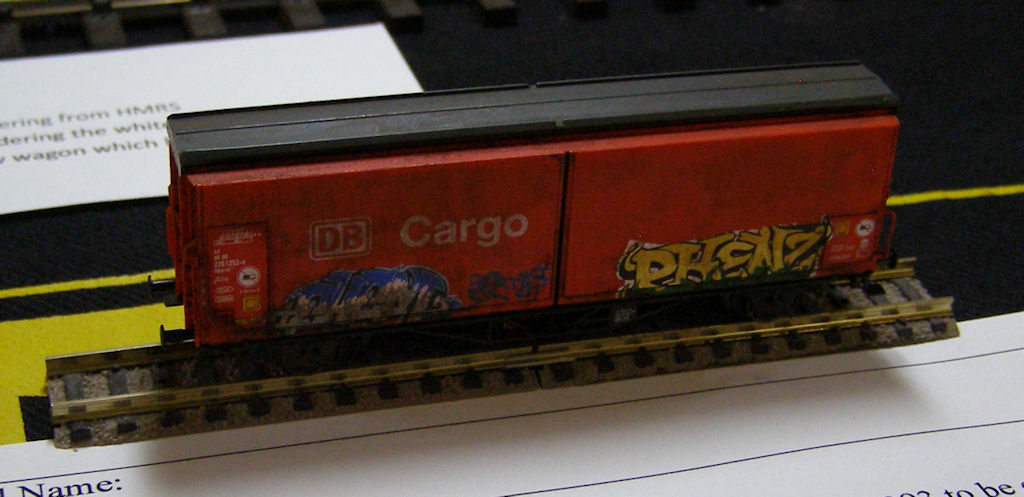Sidebar
Wheeltapper Competition 2015
Wheeltapper 2015 Competition took place Friday the 10th of April, when invited guest judge and speaker John Quick known for his knowledge of the GCR came along to Judge the models on show and then to come up with the overall winner. John has had an interest in railways for well over 60 years and was a keen train-spotter at an early age with interest in the former GCR beginning in 1960. He is a former Chairman of the Great Central Railway Society. He is also a keen modeller of GCR subjects and he has a very fine model of Brackley.
Wheeltapper Trophy
Tim Peacock (right) receiving the Wheeltapper Trophy from John Quick for his Gresley Twin Art outer suburban stock, comprising a Brake Third and a Lavatory Composite.

 The Gresley Twin Art Brake Third/Lavatory Composite set would have been matched with another third/first twin with a brake and a loose all third coach. The set was modelled using brass etches that were specially commissioned with additional parts for MJT, Wizard and Comet plus an element of scratch building. The coaches have been finished in 1955 livery by which time the first class compartments had been down-graded to third. This model was also the winner of the Passenger and NPCS Category.
The Gresley Twin Art Brake Third/Lavatory Composite set would have been matched with another third/first twin with a brake and a loose all third coach. The set was modelled using brass etches that were specially commissioned with additional parts for MJT, Wizard and Comet plus an element of scratch building. The coaches have been finished in 1955 livery by which time the first class compartments had been down-graded to third. This model was also the winner of the Passenger and NPCS Category.
Chairman’s Cup
Max Brayne(right) receiving the Trophy from Paul Wright for his Festiniog Railway Open Wagon No 118.
 Festiniog Railway Open Wagon No 118 was one of around 200 general goods wagons built and used by the Festiniog Railway. No 118 was one of the larger examples and was photographed for 'The Spooner Album' by R H Bleasdale in 1887. The model is a 5.5mm, 12mm gauge model of open wagon No 118. The model was 3D printed from his own design using basic dimensions and the photograph. the brake lever has been made from brass and the wagon runs on Parkside wheels. The livery is oxide red with black metal work which was applied to all wooden wagons originally, with the tare weights hand painted on the sides.
Festiniog Railway Open Wagon No 118 was one of around 200 general goods wagons built and used by the Festiniog Railway. No 118 was one of the larger examples and was photographed for 'The Spooner Album' by R H Bleasdale in 1887. The model is a 5.5mm, 12mm gauge model of open wagon No 118. The model was 3D printed from his own design using basic dimensions and the photograph. the brake lever has been made from brass and the wagon runs on Parkside wheels. The livery is oxide red with black metal work which was applied to all wooden wagons originally, with the tare weights hand painted on the sides.
Steam Locomotives
 The winner of the Steam Locomotives competition was Phil Baxendale for his LMS 6205 Princess Pacific locomotive in 4mm Scale. This is a P4 model was based on a Michael Edge scratch aid and a Comet tender. The locomotive is fitted with a High Level gearbox and Ultrascale wheels. The model is depicted as it would have been in 1947 before becoming LMS black (Red paint applied in 1938/9).
The winner of the Steam Locomotives competition was Phil Baxendale for his LMS 6205 Princess Pacific locomotive in 4mm Scale. This is a P4 model was based on a Michael Edge scratch aid and a Comet tender. The locomotive is fitted with a High Level gearbox and Ultrascale wheels. The model is depicted as it would have been in 1947 before becoming LMS black (Red paint applied in 1938/9).
 Max Brayne's 2-8-2 Saddle Tank No 28 was a runner up. This is a 1/4“ scale 16.5mm gauge model of a 2-8-2 saddle tank based on locomotives made by Baldwin and Alco for industrial railroads. The model started out as a Bachmann On30 2-8-0 tender engine that has been heavily modified using a resin conversion kit made by Backwoods Miniatures. The locomotive has been weathered to give the industrial look and has been fitted with DCC and sound.
Max Brayne's 2-8-2 Saddle Tank No 28 was a runner up. This is a 1/4“ scale 16.5mm gauge model of a 2-8-2 saddle tank based on locomotives made by Baldwin and Alco for industrial railroads. The model started out as a Bachmann On30 2-8-0 tender engine that has been heavily modified using a resin conversion kit made by Backwoods Miniatures. The locomotive has been weathered to give the industrial look and has been fitted with DCC and sound.
 Mick Moignard's Rio Grande Southern T-19 4-6-0 #20 was another runner up. #20 comes from southwestern Colorado, USA. A 3-foot gauge loco, it was originally built by Schenectady for Florence and Cripple Creek RR. When that closed in 9116, it was sold on to the RGS. It served the RGS until that closed in 1951. It was saved by the Rocky Mountain Railroad Club and is now owned by the Colorado Railroad museum, who have it undergoing restoration to working order at Strasburg, PA.
Mick Moignard's Rio Grande Southern T-19 4-6-0 #20 was another runner up. #20 comes from southwestern Colorado, USA. A 3-foot gauge loco, it was originally built by Schenectady for Florence and Cripple Creek RR. When that closed in 9116, it was sold on to the RGS. It served the RGS until that closed in 1951. It was saved by the Rocky Mountain Railroad Club and is now owned by the Colorado Railroad museum, who have it undergoing restoration to working order at Strasburg, PA.
The model is HO scale, running on accurate gauge 10.5mm track, HOn3. It's a heavily rebuilt PSC/Samhongsa brass model from the mid 1980s. It's been detailed to 1950 condition immediately prior to its use in the film ‘Ticket to Tomahawk’, which incidentally also starred Marilyn Monroe in her second major bigscreen appearance. Many details were changed and added, from the flanger blade on the front truck with its operating mechanism on the front deck through to the marker lamp brackets on the tender rear ladder. Specific attention was paid to the routings of the various items of pipework, with new parts such as the boiler lagging clamps, parts of the whistle assembly, cab roof electrical conduits, and much of the air piping on the tender, with parts scratchbuilt where necessary. The model is fitted with DCC and sound with the Soundtraxx TSU750 decoder in the tender, speaker in the smokebox, a contact chuff synchroniser on the first driving axle, and a working headlight. It's been finished with airbrush paint, Thinfilm decals, and weathered using the airbrush, washes, filters, drybrushing and powders.
 Finally, there’s Adrian Harford's SR 0-6-2 number 30757. It was orginally Plymouth Harbour and Docks loco number 757 so it is Just about justifiable to be used on the club’s O gauge Okehampton layout. Plymouth Harbour and Docks engines were absorbed into the SR and renumbered. Hawthorn Leslie built two of these named after company directors. The model is an Agenoria etched N/S and brass kit and has been built to 7mm finescale standards. The nameplates, etc. are by Guilplates. Adrian has painted the model in a BR livery with Fox transfers for the lining. It is fitted for DCC with sound.
Finally, there’s Adrian Harford's SR 0-6-2 number 30757. It was orginally Plymouth Harbour and Docks loco number 757 so it is Just about justifiable to be used on the club’s O gauge Okehampton layout. Plymouth Harbour and Docks engines were absorbed into the SR and renumbered. Hawthorn Leslie built two of these named after company directors. The model is an Agenoria etched N/S and brass kit and has been built to 7mm finescale standards. The nameplates, etc. are by Guilplates. Adrian has painted the model in a BR livery with Fox transfers for the lining. It is fitted for DCC with sound.
Coaching Stock and NPCS
As noted under the Wheeltapper Trophy above, Tim Peacock’s Gresley Twin Art set was also the winner of the Coaching Stock and NPCS category.
 The runner up was Adrian Harford's Coach number 2853, part of 3 set 969. This coach was built after the second world war to a Bullied design using existing Maunsell 58ft underframes. The model has been built from Mike King drawings which have been scaled up in CAD from 4mm to 7mm dimensions. The design was prepared for laser cutting in 'Romark' on the Club's laser cutter. The body has been fitted with a vacuum formed styrene roof, resin cast ends and seating by Peter Cowling. The coach handles and other fittings are by Laurie Griffin. The underframe has been built from styrene with Slaters buffer components, Roxey wheels and bogies, Peter Cowling battery boxes etc. The original livery has been applied to the model using Phoenix Precision paints by spray painting with some additional brush painting and HMRS transfers. The livery is correct for use on the club’s Okehampton layout in the 'early' BR era.
The runner up was Adrian Harford's Coach number 2853, part of 3 set 969. This coach was built after the second world war to a Bullied design using existing Maunsell 58ft underframes. The model has been built from Mike King drawings which have been scaled up in CAD from 4mm to 7mm dimensions. The design was prepared for laser cutting in 'Romark' on the Club's laser cutter. The body has been fitted with a vacuum formed styrene roof, resin cast ends and seating by Peter Cowling. The coach handles and other fittings are by Laurie Griffin. The underframe has been built from styrene with Slaters buffer components, Roxey wheels and bogies, Peter Cowling battery boxes etc. The original livery has been applied to the model using Phoenix Precision paints by spray painting with some additional brush painting and HMRS transfers. The livery is correct for use on the club’s Okehampton layout in the 'early' BR era.
Freight and Engineers Stock
 The winner of the Freight and Engineers Stock category was Ian Gearing for his Grampus DB985640 in 7mm scale. This has been constructed from an O gauge Parkside Dundas kit which has been painted and weathered with acrylic paints.
The winner of the Freight and Engineers Stock category was Ian Gearing for his Grampus DB985640 in 7mm scale. This has been constructed from an O gauge Parkside Dundas kit which has been painted and weathered with acrylic paints.
 Max Brayne's Festiniog Railway Goods Brake Van. This is a 5.5mm scale, 12mm gauge model of a goods brake van used on the Festiniog Railway. The prototype was one of a few vans that were converted from quarrymans's coaches in the early 1900s when the number of mixed trains started to decline. The model is a Malcolm Savage Models white metal kit with a separate brass chassis to include the brake detail. It is painted in a dull green as seen on most FR rolling stock when the railway was run by Colonel Stephens in the 1920s.
Max Brayne's Festiniog Railway Goods Brake Van. This is a 5.5mm scale, 12mm gauge model of a goods brake van used on the Festiniog Railway. The prototype was one of a few vans that were converted from quarrymans's coaches in the early 1900s when the number of mixed trains started to decline. The model is a Malcolm Savage Models white metal kit with a separate brass chassis to include the brake detail. It is painted in a dull green as seen on most FR rolling stock when the railway was run by Colonel Stephens in the 1920s.
 Mick Moignard's Rio Grande Southern Caboose #0401. This caboose served the RGS until the end in 1951. It was the only RGS caboose not to survive because it was blown up by vandals in the late 1950s while on display in Boulder, Co. The model is a rebuilt PSC/Dac Ha model from the mid 1980s. It sports a completely redetailed underframe, new end details and railings and other changes to bring it to 1951 appearance, including new freight car coil-spring trucks. It has been finished with airbrush painting. Thinfilm decals including the prototypical wonky numbering on the stove side. It was carefully weathered to match the photos. The model has been fitted with a DCC sound installation to provide the clickety-clack and other sounds as it rolls along as the end of the train, as well as lighting the marker lamps with correct red to rear and yellow to side and front.
Mick Moignard's Rio Grande Southern Caboose #0401. This caboose served the RGS until the end in 1951. It was the only RGS caboose not to survive because it was blown up by vandals in the late 1950s while on display in Boulder, Co. The model is a rebuilt PSC/Dac Ha model from the mid 1980s. It sports a completely redetailed underframe, new end details and railings and other changes to bring it to 1951 appearance, including new freight car coil-spring trucks. It has been finished with airbrush painting. Thinfilm decals including the prototypical wonky numbering on the stove side. It was carefully weathered to match the photos. The model has been fitted with a DCC sound installation to provide the clickety-clack and other sounds as it rolls along as the end of the train, as well as lighting the marker lamps with correct red to rear and yellow to side and front.
 James Aitken's Southern Railway Machinery Wagon, an ex LSWR low wagon which lasted well into BR days. This model has been built from an etched brass kit by Celtic Models, which has been sprayed and weathered. The lettering has been dine using HMRS transfer sheets. This model features fully soldered construction including soldering the white metal parts to the brass body with low melt solder.
James Aitken's Southern Railway Machinery Wagon, an ex LSWR low wagon which lasted well into BR days. This model has been built from an etched brass kit by Celtic Models, which has been sprayed and weathered. The lettering has been dine using HMRS transfer sheets. This model features fully soldered construction including soldering the white metal parts to the brass body with low melt solder.
 James Aitken's Southern Railway 5 Plank diagram 1380. This model has been made using laser cut parts and 3D printed components (except the wheels, buffer heads and 3 link couplings which are commercial parts. All components were drawn using CAD - ProgeCad for the laser cut parts and Solidworks for the 3D printed parts which are the buffer bodies, axel boxes, brake shoes and brake hangars. The 3D parts were made by a company called CW Railways. The final assembled model was spray painted with Precision Paints SR brown, lettered using HMRS transfers and weathered using a grey wash and dry brushing.
James Aitken's Southern Railway 5 Plank diagram 1380. This model has been made using laser cut parts and 3D printed components (except the wheels, buffer heads and 3 link couplings which are commercial parts. All components were drawn using CAD - ProgeCad for the laser cut parts and Solidworks for the 3D printed parts which are the buffer bodies, axel boxes, brake shoes and brake hangars. The 3D parts were made by a company called CW Railways. The final assembled model was spray painted with Precision Paints SR brown, lettered using HMRS transfers and weathered using a grey wash and dry brushing.
 Paul Wright's DB Box Van. This is a Fleischmann model of a modern DB box van (and HBIS tt293 to be exact) with added graffiti and dirt.
Paul Wright's DB Box Van. This is a Fleischmann model of a modern DB box van (and HBIS tt293 to be exact) with added graffiti and dirt.
 Ian Gearing's GWR Fruit Van. This is anO gauge Parkside kit straight out of the box.
Ian Gearing's GWR Fruit Van. This is anO gauge Parkside kit straight out of the box.
 James Aitken's GW Loco Coal Wagon. This model has been built from a Cooper Craft plastic kit, and lettered using HMRS transfers. The buffers were modified by drilling through in a lathe to take Parkside Dundas buffer heads and springs because the buffers sold in the kit are nasty! the oversize links in the kit were also replaced with better scale ones.
James Aitken's GW Loco Coal Wagon. This model has been built from a Cooper Craft plastic kit, and lettered using HMRS transfers. The buffers were modified by drilling through in a lathe to take Parkside Dundas buffer heads and springs because the buffers sold in the kit are nasty! the oversize links in the kit were also replaced with better scale ones.
Road Vehicles, Boats, People, Animals etc
 The winner of The Robbie Robinson Award for road vehicles, boats, people, and animals was Paul Wright for his Mechanical Horse in 7mm scale. This is a model of a Scammell 3 ton Mechanical Horse and trailer built from a white metal kit, painted in acrylics. It has been finished in Southern Railway colours as this model will be part of the Okehampton layout.
The winner of The Robbie Robinson Award for road vehicles, boats, people, and animals was Paul Wright for his Mechanical Horse in 7mm scale. This is a model of a Scammell 3 ton Mechanical Horse and trailer built from a white metal kit, painted in acrylics. It has been finished in Southern Railway colours as this model will be part of the Okehampton layout.
 Another entry in this category was Paul Wright's Donkeys in 1:43 scale. These are a pair of plastic O scale donkeys painted in acrylics.
Another entry in this category was Paul Wright's Donkeys in 1:43 scale. These are a pair of plastic O scale donkeys painted in acrylics.
 Also Paul Wright's Dutch Barge in 1:160 scale. This is a Dutch barge of the spitz type. It has been built from an Artitec resin and etched brass kit, painted in acrylics with rigging from cotton thread. The barge is carrying a load of sand and when mounted in the canal will be set low in the water.
Also Paul Wright's Dutch Barge in 1:160 scale. This is a Dutch barge of the spitz type. It has been built from an Artitec resin and etched brass kit, painted in acrylics with rigging from cotton thread. The barge is carrying a load of sand and when mounted in the canal will be set low in the water.
 Finally there’s Paul Wright's People for Okehampton. These are white metal figures sculpted by Aiden Campbell, painted in acrylics. The population of Okehampton is steadily growing.
Finally there’s Paul Wright's People for Okehampton. These are white metal figures sculpted by Aiden Campbell, painted in acrylics. The population of Okehampton is steadily growing.
Scenic Models: Buildings, Trees, Signals etc
 The winner of the Jack Cline Trophy for Scenic Models: Buildings, Trees and Signals was Paul Wright for his 1:160 Pigsty. This has been built from an Artitec resin kit, painted in acrylics with acrylic washes. The ridge is made from lead.
The winner of the Jack Cline Trophy for Scenic Models: Buildings, Trees and Signals was Paul Wright for his 1:160 Pigsty. This has been built from an Artitec resin kit, painted in acrylics with acrylic washes. The ridge is made from lead.
Scenic Models for Aylesbury P4 Layout
 Gary Day's Aylesbury (North) Footbridge. A 4mm = 1ft scratch built model of Aylesbury North footbridge. The Steelwork is formed from brass angle sections. The Pillar Columns are Plastistruct. The Mesh Screen is Scalelink fret. The Bridge Deck is formed from a plasticard & brass composite with wet and dry surfacing. The Smoke Deflectors are made from Brass sheet and Angle. The Bridge Piers are laser cut Romark.
Gary Day's Aylesbury (North) Footbridge. A 4mm = 1ft scratch built model of Aylesbury North footbridge. The Steelwork is formed from brass angle sections. The Pillar Columns are Plastistruct. The Mesh Screen is Scalelink fret. The Bridge Deck is formed from a plasticard & brass composite with wet and dry surfacing. The Smoke Deflectors are made from Brass sheet and Angle. The Bridge Piers are laser cut Romark.
 David Lane's Aylesbury Platform Hut. Originally built as a signal box by the Aylesbury & Buckingham Railway, but was superseded by a GWR signal box in 1892. The building survived until the early 1990s. The model was drawn in CAD then laser cut from MDF and Rowmark. The model sits within the platform ramp hence why the doorway sits in mid-air.
David Lane's Aylesbury Platform Hut. Originally built as a signal box by the Aylesbury & Buckingham Railway, but was superseded by a GWR signal box in 1892. The building survived until the early 1990s. The model was drawn in CAD then laser cut from MDF and Rowmark. The model sits within the platform ramp hence why the doorway sits in mid-air.
 David Lane's Aylesbury Up Waiting Room. Designed from site surveys and drawn up using CAD. It has then been laser cut from various layers of Romark sheet. The model has the correct quarter bricks around doors and corners. The model will sit under the station canopies so some supporting ironwork and stone coping areas will be added when the canopies are fitted.
David Lane's Aylesbury Up Waiting Room. Designed from site surveys and drawn up using CAD. It has then been laser cut from various layers of Romark sheet. The model has the correct quarter bricks around doors and corners. The model will sit under the station canopies so some supporting ironwork and stone coping areas will be added when the canopies are fitted.
 David Lane's Aylesbury Down Waiting Room. Designed from site surveys and drawn up using CAD and then laser cut from various layers of Romark sheet. Model has the correct quarter bricks around doors and corners. The model will sit under the station canopies so some supporting ironwork and stone coping areas will be added when the canopies are fitted.
David Lane's Aylesbury Down Waiting Room. Designed from site surveys and drawn up using CAD and then laser cut from various layers of Romark sheet. Model has the correct quarter bricks around doors and corners. The model will sit under the station canopies so some supporting ironwork and stone coping areas will be added when the canopies are fitted.




